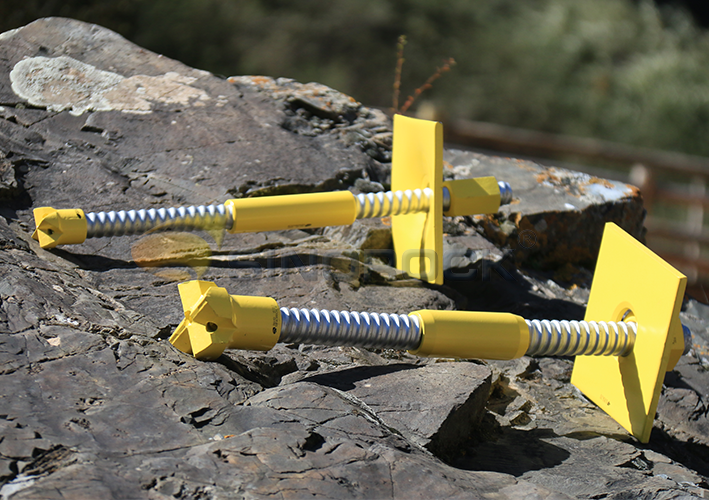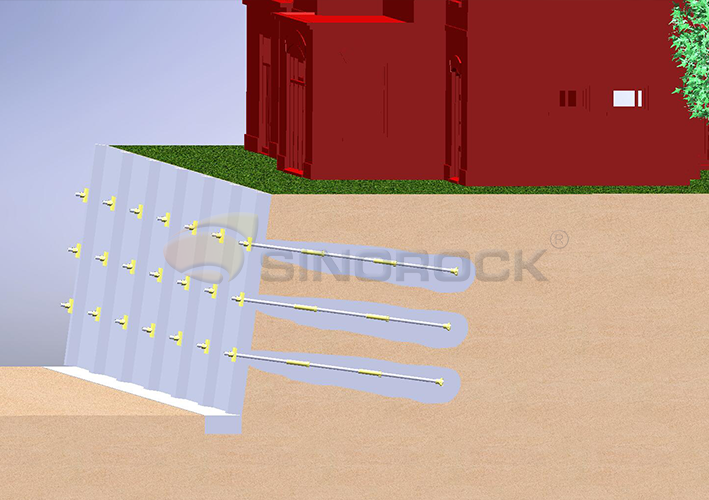4 Advantages of Self-drilling Hollow Grouting Anchors compare with common Grouted Bolts
Time:2024-02-23From:sinorock View:
I. Introduction of Sinorock Self-drilling Hollow Grouting Anchors and Common Grouted Bolts
Geotechnical engineering plays a critical role in ensuring the stability and safety of various structures, especially in challenging geological conditions. One innovative solution that has gained prominence is the Sinorock Self-Drilling Hollow Grouting Anchor. This article explores the advantages of this anchor system compared to the traditional Common Grouted Bolts in the current state of the industry.

II. What are Sinorock Self-drilling Hollow Grouting Anchors and Common Grouted Bolts?
a. Self-drilling Hollow Grouting Anchors
Sinorock self-drilling hollow grouting anchor is comprised of a hollow bar, a drill bit, a coupler, a centralizer, a plate and a nut. It is a new type of bolt which can perform drilling, grouting and anchoring in a single operation.
The hollow anchor bar of self-drilling hollow grouting anchor is fully threaded, that can be cut to any length or extended according to the needs of the project. Grouting through the hollow bar can improve the grouting compactness, thereby improving the bond stress to the rock and also improving the durability of the bolt. Self-drilling hollow grouting anchor is especially suitable for weak, broken and other difficult formations.
b. Common Grouted Bolts
Common grouted bolt is an anchoring agent that uses cement mortar. This type of anchor rod is easy to install, low in cost, but weak in anchoring force. It is mostly used for slope protection with relatively complete rock structure or temporary anchoring. It is rare used underground but mostly used in tunnel construction. Grouted bolt must be injected into the hole with mortar before inserting the bolts. The bonding force between the bolts and the surrounding rock is not as good as the Self-drilling hollow grouting anchor and with less grouting choice of grout. It has a variety of reinforcement effects on the surrounding rock. Thus the reinforcement effect on the surrounding rock is also worse.
III. Compare Self-Drilling Hollow Grouting Anchors Over Common Grouted Bolts in Geotechnical Engineering
a. Grouting Quality and Effective Anchorage Length
Common Grouted Bolts: The weakness in the grouting fullness of Common Grouted Bolts results in gaps and cavities between the rod body and the rock wall. This compromises the effective anchorage length area, reducing the overall stability.
Sinorock Self-drilling Hollow Grouting Anchor: With a focus on enhanced grouting compactness, the hollow bar design ensures better control over grouting fullness. This, in turn, guarantees the desired effective anchorage length area, and if required, the option for pressure grouting further fortifies the rod's surroundings.
b. Pallet Force and Prestress
Common Grouted Bolts: Common Grouted Bolts lack supporting board force and prestress capabilities, limiting their ability to strengthen the rock mass.
Sinorock Self-drilling Hollow Grouting Anchors: The inclusion of support plate force in Self-drilling Hollow Grouting Anchors allows for prestressing of the rock mass. This feature improves the shear strength of weak structural surfaces and potential slip zones and can form a compressive stress arch zone in the anchorage area of the rock mass under certain conditions.

c. Adaptability to Weak Rock Formations
Common Grouted Bolts: The construction of Common Grouted Bolts in weak and broken geological conditions is often unfeasible.
Sinorock Self-drilling Hollow Grouting Anchors: The Self-drilling Hollow Grouting Anchors, designed to combine drilling and grouting in a single operation, provide versatility. They can be effectively deployed in weak and broken geological conditions, showcasing a superior adaptability.
d. Durability
Common Grouted Bolts: Uneven protection thickness due to incomplete mortar filling and off-centered rod bodies leads to poor durability of Common Grouted Bolts.
Sinorock Self-drilling Hollow Grouting Anchors: The hollow design ensures full grouting between the rod body and the hole wall. The centralizer ensures the centered position of the rod body, resulting in a uniformly thick protective layer. This meticulous construction contributes to the exceptional durability of Self-drilling Hollow Grouting Anchors.
IV. Conclusion
In summary, Sinorock Self-drilling Hollow Grouting Anchors stand out with their rapid construction speed, substantial anchoring force, excellent anti-corrosion performance, and user-friendly operation. While the initial unit cost might be higher than that of Common Grouted Bolts, the long-term benefits, especially in terms of durability, make them a superior investment. The ability to anchor over the entire length of the bolt, coupled with a consistently uniform protective layer, significantly enhances the implicit economic benefits of Self-drilling Hollow Grouting Anchors. When it comes to geotechnical engineering, the advantages they offer surpass those of the more traditional Common Grouted Bolts, making them a preferred choice for engineers and construction professionals.
latest news
-

- 3 Crucial Factors That Impact the Quality of Self-Drilling Hollow Bolts
- Time:2025-01-26From:This Site
- As we all know, the quality of the self-drilling hollow bolts is vital to the whole project. It determines if the project is safe for the people in future use. Then, what will affect the quality of the self-drilling hollow bolts?
- View details
-

- Self-Drilling Anchor Bolt Construction in Complex Geological Slope
- Time:2025-01-24From:This Site
- During construction, Self-drilling hollow anchor bolt integrates drilling, grouting and anchoring functions, which significantly improves drilling efficiency. And under the action of pressure pump, the grouting in the rock strata and voids is full, which ensures the grouting thickness and anchoring effect.
- View details
-

- How Does Self-drilling Rock Bolt Drill in Quicksand Geological Condition?
- Time:2025-01-19From:This Site
- This in-depth guide explores how self-drilling rock bolts function in quicksand geological conditions, covering the challenges, construction methods, and best practices for ensuring effective anchorage in unstable, fluidic soil layers.
- View details
-

- Quality Control: the Vital Factor of A SDA Bolt Factory
- Time:2025-01-09From:This Site
- Sinorock’s comprehensive quality control system, from supplier management to outgoing inspections, ensuring the highest standards for self-drilling anchor bolts in construction.
- View details
-
.png)
- International Women's Day with Strawberry-picking
- Time:2024-03-09From:This Site
- Marked the annual observance of International Women's Day, and to commemorate this significant event, Sinorock organized a special strawberry-picking event exclusively for its female employees.
- View details
-

- Celebrate the 74th anniversary of the founding of the People's Republic of China
- Time:2023-10-01From:This Site
- On October 1st every year, we observe the annual National Day, commemorating the birth of our beloved motherland.
- View details
-
.jpg)
- SINOROCK to Attend EXPOMINA PERÚ 2024 in Lima, Peru
- Time:2024-08-10From:This Site
- Sinorock to Attend EXPOMINA PERÚ 2024 in Lima, Peru
- View details
-
.jpg)
- SINOROCK to Participate in MINING AND METALS CENTRAL ASIA 2024
- Time:2024-08-08From:This Site
- SINOROCK to Participate in MINING AND METALS CENTRAL ASIA 2024
- View details
-

- SINOROCK Gears Up for UGOL ROSSII & MINING 2024 with Custom Mining Solutions
- Time:2024-05-15From:This Site
- SINOROCK is thrilled to announce its participation in the highly anticipated 32nd International Trade Fair for Mining Technology, UGOL ROSSII & MINING 2024. The event will take place at the Exhibition complex "Kuzbass Fair" in Novokuznetsk, Kemerovo region - Kuzbass, Russia, from June 4th to 7th, 2024.
- View details
 Download
Download 


